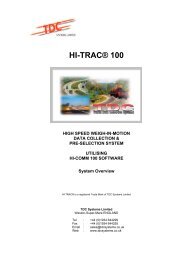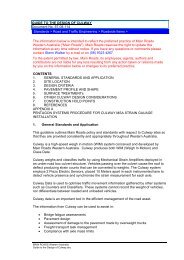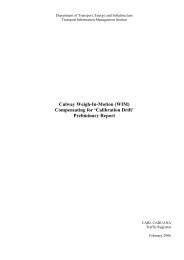Instruction Manual, Type 9195E - WIM
Instruction Manual, Type 9195E - WIM
Instruction Manual, Type 9195E - WIM
You also want an ePaper? Increase the reach of your titles
YUMPU automatically turns print PDFs into web optimized ePapers that Google loves.
Frequently Asked Questions (FAQ)<br />
12. Frequently Asked Questions (FAQ)<br />
Available lengths of Lineas ® sensors<br />
The lengths of the Lineas sensors are 1,00 m and 0,75 m.<br />
For one row across a lane 4 sensors are usually required.<br />
The standard configuration is 2 sensor rows per lane.<br />
Please check carefully the actual lane width at the planned<br />
<strong>WIM</strong> sites and be aware that the regular cable length<br />
attached to the Lineas is 40 m and 100 m thus the electronic<br />
cabinet should not be too far away.<br />
Responsibility of an installation<br />
It is a requirement of Kistler that the installation is supervised<br />
by a Kistler engineer or Kistler certified engineer.<br />
This Kistler certified Engineer is responsible for the whole<br />
installation, the discontinuance in case the requirements<br />
are no longer met, as well as for the time of opening of the<br />
lane for traffic.<br />
Kistler is happy to assist and train the customer at cost price<br />
and will issue a certificate (for person not organization) if the<br />
installation and training were successful. The certificate is valid<br />
for a specified time.<br />
Companies who are interfacing the Lineas ®<br />
sensor<br />
There are several companies in Europe, North America, the<br />
Far East and Australia that have successfully adapted their<br />
electronics and software to integrate the Lineas sensor into<br />
their measuring chain.<br />
Regrinding of the Lineas ®<br />
sensor<br />
Lineas sensors have a topcoat with a thickness of 10 mm<br />
(the same material as the grouting material) designed for<br />
re-profiling by grinding less than 9 mm.<br />
If a pavement has a rut depth of e.g. 10 mm, the road<br />
cannot be regarded as a suitable <strong>WIM</strong> site, as vertical<br />
oscillations of the vehicles will induce dynamic weight<br />
deviations which exceed the requirements considerably.<br />
It is strongly recommended to have a pavement without<br />
rutting before installing the <strong>WIM</strong> site. If there is already a<br />
rutting of above 4mm, we suggest to repave the road. It is<br />
very important to have an even surface in order to achieve<br />
excellent results.<br />
Traveling over the Lineas ® sensor with a flat tire<br />
The load bearing capacity of the Lineas surface is over<br />
200 kN per twin wheel and local load concentrations up to<br />
the Mega Pascal range had been tested successfully. From<br />
all the sensors operating in many countries, we have no<br />
indication that flat runners have ever caused a failure.<br />
Performance over the total sensor length at delivery<br />
Kistler guarantees that all delivered Lineas sensors have a<br />
uniform sensitivity within +/-3 % over the length of the<br />
sensor. One channel usually consists of 2 sensors which are<br />
paired according to their sensitivity and have an uniformity<br />
of approx. +/-3 % over the width of the whole measuring<br />
channel.<br />
002-300e-07.04 (200-348e) Page 27
















